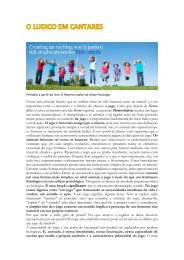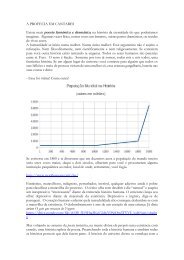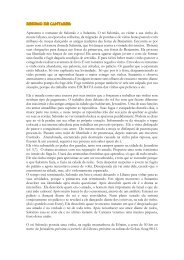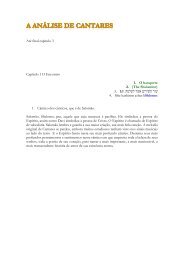Motherhood in Childhood
Create successful ePaper yourself
Turn your PDF publications into a flip-book with our unique Google optimized e-Paper software.
prepares girls for jobs and livelihoods, raises their<br />
self-esteem and their status <strong>in</strong> their households<br />
and communities, and gives them more say <strong>in</strong><br />
decisions that affect their lives. Education also<br />
reduces the likelihood of child marriage and<br />
delays childbear<strong>in</strong>g, lead<strong>in</strong>g eventually to healthier<br />
birth outcomes. Leav<strong>in</strong>g school—because of<br />
pregnancy or any other reason—can jeopardize a<br />
girl’s future economic prospects and exclude her<br />
from other opportunities <strong>in</strong> life.<br />
Many forces conspir<strong>in</strong>g aga<strong>in</strong>st<br />
adolescent girls<br />
An “ecological” approach to adolescent pregnancy<br />
is one that takes <strong>in</strong>to account the full range of<br />
complex drivers of adolescent pregnancy and the<br />
<strong>in</strong>terplay of these forces. It can help governments,<br />
policymakers and stakeholders understand the<br />
challenges and craft more effective <strong>in</strong>terventions<br />
that will not only reduce the number of pregnancies<br />
but that will also help tear down the many<br />
barriers to girls’ empowerment so that pregnancy<br />
is no longer the likely outcome.<br />
One such ecological model, developed by<br />
Robert Blum at the Johns Hopk<strong>in</strong>s Bloomberg<br />
School of Public Health, sheds light on the<br />
constellation of forces that conspire aga<strong>in</strong>st the<br />
adolescent girl and <strong>in</strong>crease the likelihood that<br />
she will become pregnant. While these forces are<br />
numerous and multi-layered, they all, <strong>in</strong> one way<br />
or another, <strong>in</strong>terfere with a girl’s ability to enjoy<br />
or exercise rights and empower her to shape her<br />
own future. The model accounts for forces at<br />
the national level—such as policies regard<strong>in</strong>g<br />
adolescents’ access to contraception or lack of<br />
enforcement of laws bann<strong>in</strong>g child marriage—<br />
all the way to the level of the <strong>in</strong>dividual, such<br />
as a girl’s socialization and the way it shapes<br />
her beliefs about pregnancy.<br />
Most of the determ<strong>in</strong>ants <strong>in</strong> this model<br />
operate at more than one level. For example,<br />
national-level policies may restrict adolescents’<br />
PRESSURES FROM MANY DIRECTIONS AND LEVELS<br />
An “ecological” approach to adolescent pregnancy is one that takes <strong>in</strong>to account the full<br />
range of complex drivers of adolescent pregnancy and the <strong>in</strong>terplay of these forces.<br />
Pressures from all levels conspire aga<strong>in</strong>st girls and lead to pregnancies, <strong>in</strong>tended or otherwise. National laws may prevent a<br />
girl from access<strong>in</strong>g contraception. Community norms and attitudes may block her access to sexual and reproductive health<br />
services or condone violence aga<strong>in</strong>st her if she manages to access services anyway. Family members may force her <strong>in</strong>to<br />
marriage where she has little or no power to say “no” to hav<strong>in</strong>g children. Schools may not offer sexuality education, so she<br />
must rely on <strong>in</strong>formation (often <strong>in</strong>accurate) from peers about sexuality, pregnancy and contraception. Her partner may refuse<br />
to use a condom or may forbid her from us<strong>in</strong>g contraception of any sort.<br />
vi<br />
INDIVIDUAL<br />
FAMILY<br />
SCHOOL/PEERS<br />
COMMUNITY

















